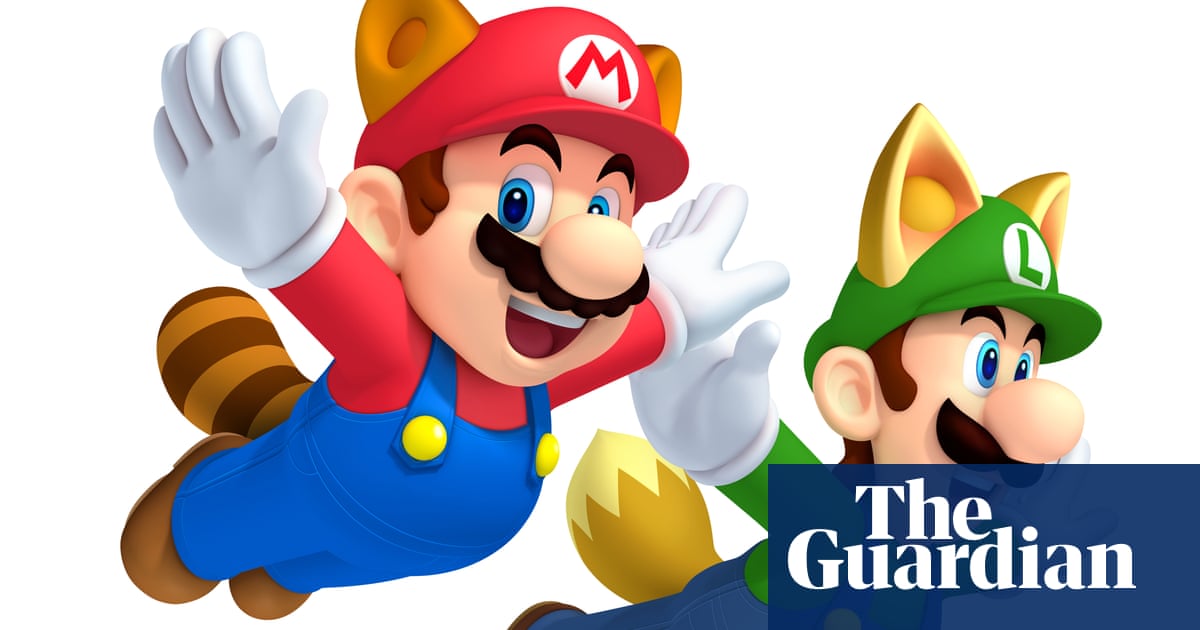
Every Nintendo fan remembers the game that converted them. Perhaps it was running and jumping around as Mario in an abstract, toylike playspace, thrilling at the lightness and precision of his movement. It could have been becoming hypnotised by falling Tetris blocks on the Game Boy’s tiny monochrome screen, or choosing a first Pokémon, marvelling at how the little collection of fat pixels representing your chosen critter instantly assumed an imagined personality. Millions of people had their first Nintendo moment during 2020’s lockdowns, moving to a virtual deserted island full of quirky neighbours in Animal Crossing.
For more than 40 years, this Japanese giant of entertainment has been making video games that have shaped the tastes of the people who played them as children; there is surely no game developer working today who is untouched by its influence. Its latest console, meanwhile – the Nintendo Switch, released in 2017 – recently became the fastest ever to reach 100m sales, and stands a good chance of becoming the bestselling console ever. Barring an extremely unlikely sales slump over Christmas, the Switch will leapfrog to No 3 on the bestselling list when Nintendo announces its quarterly results this week. Only the DS and Sony’s PlayStation 2 are ahead of it.
Few companies enjoy such staying power in the novelty-hungry, fast-moving world of video games – or even the wider world of pop culture. Mario first appeared in Donkey Kong in 1981, and is about to make a mid-career pivot and star in his first animated film this year. (Shh, nobody mention 1993’s utterly bizarre live-action Super Mario Bros movie, featuring Bob Hoskins as Mario: everyone, including the actors who starred in it, would rather forget that ever happened.) And for those who want to immerse themselves further, there is even a California theme park: Super Nintendo World. Yes, others have challenged Nintendo’s creative and commercial dominance, sometimes successfully – particularly Sega in the early 1990s, and Sony throughout the 00s. Smartphones and online gaming have reshaped video games and how we play and think about them since we first picked up a sword in The Legend of Zelda. But whatever else has been happening in the world, Nintendo has kept quietly doing its own, inimitable, sometimes weirdly archaic thing in its secluded Kyoto HQ, seemingly unbothered by the competition.
What is behind this success? The obvious answer is that Nintendo’s games are really, really good – some of the best ever made; colourful capsule universes that spark imagination and playfulness, however old they (or their players) are. Its technological innovations are significant, too: the directional buttons and analogue sticks that still appear on practically every video game controller were first seen on Nintendo’s consoles. But if you look closely at the history of the company and its creative output, you’ll see something else: a thirst for experimentation that comes with a willingness to fail.
“It’s crazy that Nintendo has stayed so relevant for so long. Is any other stable of characters developed in the 1980s still so commercially and culturally relevant today?” says Chris Kohler, editorial director at video game preservationists Digital Eclipse and author of Power-Up: How Japanese Video Games Gave the World an Extra Life. “How is this even possible? I think Nintendo has been great at growing and retaining talent and ensuring that continuity of game design knowhow … Nintendo has always followed a gameplay-first design philosophy: get something down that’s fun to play, and then start thinking about the story, the characters.”
Fun first is a principle that can be traced back to before Nintendo made video games. Before Mario, Nintendo was a toymaker; before that, from 1899 until the 1960s, Nintendo made hanafuda playing cards, favoured by everyone from families to, reportedly, the yakuza. Hiroshi Yamauchi, Nintendo’s president from 1949 until 2002, was the person who led the company’s transformation; starting in the 60s, he encouraged the engineer Gunpei Yokoi – first hired to fix the machines that made its playing cards – to experiment with electronic and mechanical toys.
“It seemed as if the designers at Nintendo at the time almost got carte blanche,” explains Erik Voskuil, who has been collecting Nintendo curios for more than 20 years and runs Before Mario, a site dedicated to the company’s pre-video game history. “They tried many ideas to see what would sell, including some truly wacky ones: a remotely controlled racing car that can only steer left, a mini-vacuum cleaner and a walkie-talkie that transmits sound through light.”
Some of Yokoi’s toys were commercially successful: 1966’s Ultra Hand, an extendable gripper toy; the Love Tester, from 1969, which asked couples to hold an electrode each and then scored their chemistry out of 100. (His most successful invention would be none other than the Game Boy, released in 1989). “People working at Nintendo today are very much aware of the company’s history,” says Voskuil. “The company culture formed at that time largely endures to this day: daring to be innovative, which also includes accepting the occasional failure, and getting the maximum amount of fun out of clever use of modest technical means.”
The weirdness of Nintendo’s toys lives on in many of its games consoles. Nintendo has rarely been on the cutting edge technologically; instead, its research-and-development engineers have found ways to do unexpected things with technology that already exists. When Microsoft’s Xbox was perfecting online play on a home console in 2006, Nintendo released the resolutely offline multiplayer-focused Wii and its novel motion-powered controller, which instantly became a bestseller. A few years before the dawn of the age of smartphones, Nintendo put out the DS, which looks like a cross between an old Japanese mobile phone and a Palm Pilot.
Not all Nintendo’s consoles have been wild successes. Two of its biggest flops were the headache-inducing Virtual Boy, a bright-red set of 3D goggles that debuted in 1995, and the awkward follow-up to the Wii, the Wii U. But it is the company’s willingness to experiment that sets it apart. And because Nintendo has always sought to make money on everything it sells – instead of spending fortunes manufacturing and selling technologically advanced consoles at a loss before making its money back through the games themselves, as Microsoft and Sony do – it has a multibillion-dollar war chest that comes in very useful when one of its games or consoles just doesn’t land.
Another huge component in Nintendo’s enduring success is that its games were the first to become truly multigenerational. Kids who grew up with Mario, Zelda and Pokémon on the Game Boy are now playing those games with their own kids on the Switch – both the newer iterations and the originals. It may seem weird that fully grown adults would continue to love games that are overtly and unashamedly family friendly, but for some Nintendo fans, that’s part of the point. Nintendo represents an uncomplicatedly fun approach to video games, a bridge back to the joy and excitement of childhood play.
The visual style of Nintendo, too, radiates joy: colourful, cartoonish, cute but not infantile. It’s Pixar, not Fisher Price. The aesthetic varies from game to game, from modern Zelda’s wistful watercolour landscapes to Splatoon’s in-your-face Harajuku-esque street-fashion to Animal Crossing’s cute-but-weird, intentionally lo-fi vibe, but it is always welcoming. It has inspired legions of artists and fashion bloggers, who fill Instagram with Nintendo-inspired art, interior design, outfits, even food.
“Nintendo’s games are a welcome alternative to the realistic but rather grim and foreboding titles on rival systems,” says Damien McFerran, editorial director at retro games site Time Extension, who previously ran specialist site Nintendo Life for many years. “It might seem rather childish for someone in their 40s to say this, but I’m a sucker for the bright colours and breezy, inoffensive atmosphere fostered in Nintendo’s games. I can safely play a title such as Super Mario Odyssey and not only be sure it’s not going to cause upset but know, too, that I’ll have a good time myself.”
A lot of Nintendo’s games have their roots in childhood experiences. Its most famous game designer, Shigeru Miyamoto, was inspired to create The Legend of Zelda in the 1980s by his own youthful explorations of the woodlands and caves of the Japanese countryside. Pokémon’s mastermind, Satoshi Tajiri, used to capture and collect bugs as a kid, and imagined the virtual critters in his games crawling across the link cables that joined players’ Game Boys together. There is a difference between childlike and childish. Nintendo trades in fun and wonder, in little “wow” moments, in the words of veteran Nintendo designers Shinya Takahashi and Hisashi Nogami. Whether you’re playing Animal Crossing: New Horizons or Nintendo Labo, a game about turning cardboard models into working pianos and fishing rods with the help of the Switch controllers, the aim is to create a sense of delight.
To protect that, Nintendo has to preserve its willingness to mess around, take risks and occasionally release games that aren’t destined to be bestsellers. Chris Kohler wonders whether the wildness of “weird Nintendo” – the Nintendo that put out a series of bizarre, sometimes side-splitting musical skits in the form of Rhythm Paradise, or the WarioWare mini-game collection that you controlled by rotating the Game Boy Advance – is fading, now that the elders who built the company’s creative culture have left, aged out or passed away. “I feel like Nintendo of late has retreated into safe mega-brands,” says Kohler. “We’re seeing a lot of Mario, Zelda, Kirby and [anime strategy series] Fire Emblem, which, it should be noted, has been probably the biggest surprise success of the last few years for Nintendo. The weird experimental stuff that we used to see a lot of on Wii and 3DS is nowhere to be found on the Switch.”
A successor to the Switch has been rumoured for some time, and conventional wisdom suggests that the company should be hard at work on a more technologically advanced successor. But since when has Nintendo ever followed conventional wisdom? For Erik Voskuil, familiarity is no bad thing. After all, Nintendo makes some of the best games in the world; is it so bad to have more of the same? “From the time Nintendo reached global success in the 1980s, it has managed to stay both familiar as well as exciting; a golden formula,” he says. “In the end, it comes down to this: Nintendo makes people smile.”












